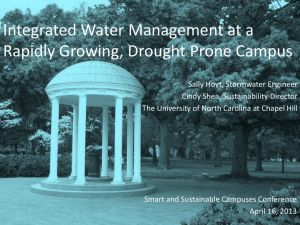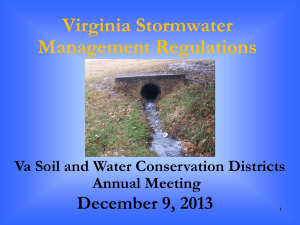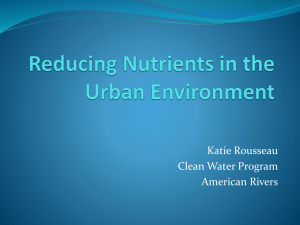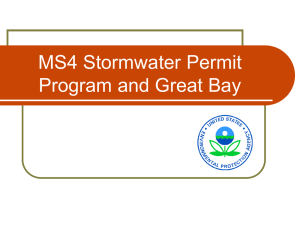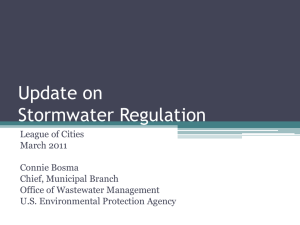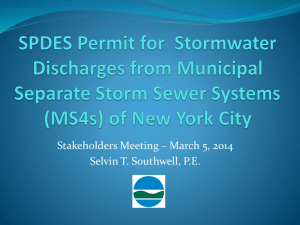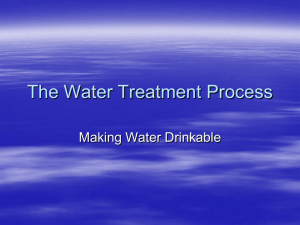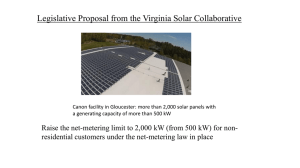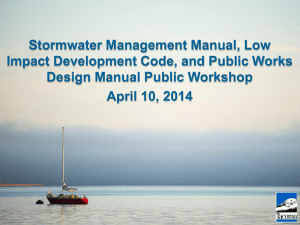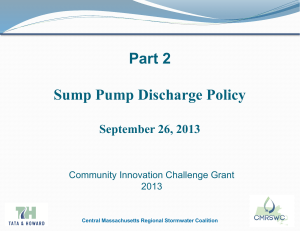MDE Presentation - Storm Overview: 12
advertisement
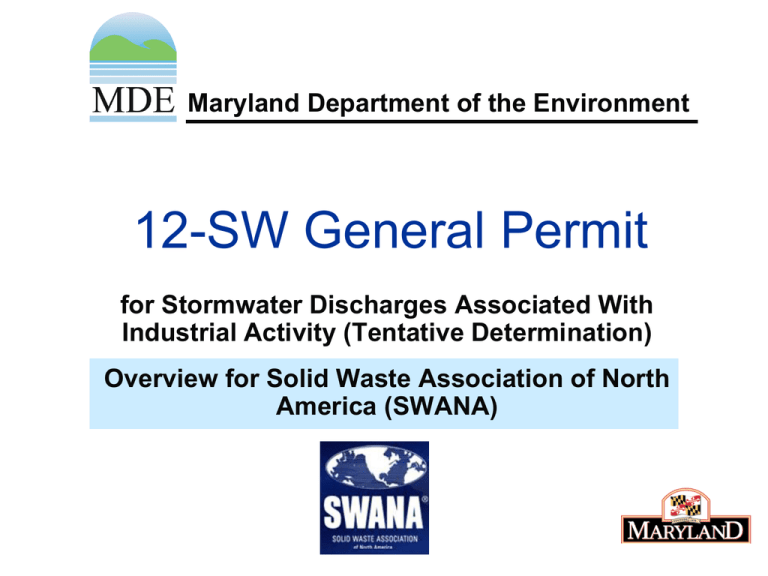
Maryland Department of the Environment 12-SW General Permit for Stormwater Discharges Associated With Industrial Activity (Tentative Determination) Overview for Solid Waste Association of North America (SWANA) History of Stormwater Permit • The Clean Water Act (CWA or the Act) establishes a comprehensive program – “to restore and maintain the chemical, physical, and biological integrity of the Nation’s waters.” – “also seeks to attain ‘water quality which provides for the protection and propagation of fish, shellfish and wildlife.’” • The Water Quality Act of 1987 (WQA) directed the EPA to develop a phased approach to regulate stormwater discharges under the NPDES permit program. • EPA published a final regulation on November 16, 1990, establishing permit application requirements for “stormwater discharges associated with industrial activity”. • EPA issues stormwater permits for many states, which is referred to as the Multi-Sector General Permit (MSGP). Maryland’s General Permit • Maryland is a delegated State and has authority to issue NPDES permits. • Maryland issued our own permit for “stormwater discharges associated with industrial activity” in 1992, to meet the CWA requirements. • Permits expire every 5 years and must be reissued. • The General Permit 02-SW expired on November 30, 2007, but is administratively extended. • This proposed 12-SW permit would replace the 02SW, and is largely based on the MSGP. What is the Big Deal? Impacts on Stream Flow Hot Spots Stormwater hotspots are areas which produce higher concentrations of pollutants than normally found in urban runoff. Who is Covered? Facilities with stormwater discharges: a) associated with industrial activity (defined in Appendix E) b) from a primary industrial activity (identified in Appendix A) OR facilities that are notified by MDE as eligible for coverage under Sector AD. Industrial Activity Includes • industrial plant yards; • immediate access roads and rail lines used or traveled by carriers of raw materials, manufactured products, waste material, or byproducts used or created by the facility; • material handling sites; refuse sites; • sites used for the application or disposal of process waste waters; • sites used for the storage and maintenance of material handling equipment; Industrial Activity also Includes • sites used for residual treatment, storage, or disposal; • shipping and receiving areas; • manufacturing buildings; • storage areas (including tank farms) for raw materials, and intermediate and final products; • and areas where industrial activity has taken place in the past and significant materials remain and are exposed to stormwater. Industrial Activity Excludes: • Areas located on plant lands separate from the plant's industrial activities, such as office buildings and accompanying parking lots as long as the drainage from the excluded areas is not mixed with stormwater drained from the above described areas. Primary Industrial Activity-Sectors Sector A – Timber Products Sector P – Land Transportation Sector B – Paper and Allied Products Manufacturing Sector Q – Water Transportation Sector C – Chemical and Allied Products Manufacturing Sector R – Ship and Boat Building or Repairing Yards Sector D – Asphalt Paving and Roofing Materials Manufactures and Lubricant Manufacturers Sector S – Air Transportation Facilities Sector E – Glass, Clay, Cement, Concrete, and Gypsum Product Manufacturing Sector T – Treatment Works Sector F – Primary Metals Sector U – Food and Kindred Products Sector G – Not currently covered in this permit. Sector V – Textile Mills, Apparel, and other Fabric Products Manufacturing Sector H – Not currently covered in this permit. Sector W – Furniture and Fixtures Sector I – Oil and Gas Extraction and Refining Sector X – Printing and Publishing Sector J – Not currently covered in this permit. Sector Y – Rubber, Miscellaneous Plastic Products, and Miscellaneous Manufacturing Industries Sector K – Hazardous Waste Treatment Storage or Disposal Sector Z – Leather Tanning and Finishing Sector L – Landfills and Land Application Sites Sector AA – Fabricated Metal Products Sector M – Automobile Salvage Yards Sector AB – Transportation Equipment, Industrial or Commercial Machinery Sector N – Scrap Recycling Facilities Sector AC – Electronic, Electrical, Photographic and Optical Goods Sector O – Steam Electric Generating Facilities Sector AD –Designated by the Department Application Process • Within 90 days of reissuance, you must submit a completed Notice of Intent (NOI), updated Stormwater Pollution Prevention Plan (SWPPP) and fee. • NOI will require some additional information relating to the impervious surface calculations. • NOI will require you to determine if discharging to an impaired stream. Coverage Exemption “No Exposure Certification” Requires: 1. no potential for the stormwater discharged…to be exposed to pollutants, 2. And discharge into watersheds without water quality impairments for nutrients or suspended solids. The evolution of stormwater management requirements Pollution Prevention (02-SW) • Stormwater Pollution Prevention Plan (SWPPP) describes and ensures the implementation of practices used to reduce pollutants in stormwater discharges. – Map with potential sources and controls to deal with them. – Summary of sampling points. – Identify Pollution Prevention Team. – Plans and records of Employee Training. • Amendment of plan required when there was a new potential for discharge or if the Plan proved to be ineffective. Best Management Practices (BMP) • Prevent or reduce pollution by: – schedules of activities – prohibitions of practices – maintenance procedures, and – other management practices. • Control plant site runoff, spillage or leaks or drainage by: – treatment requirements, – operating procedures, and – other practices. Stormwater Management Development of a description of stormwater management controls (or BMPs) appropriate for the facility, and implementation of such controls. a. A preventive maintenance program b. Good housekeeping c. Spill prevention and response procedures d. Prevent sediment and erosion Storm water management… e. Identification of traditional stormwater management practices (practices other than those which control the generation or source(s) of pollutants) used to divert, infiltrate, reuse, or otherwise manage stormwater runoff in a manner that reduces pollutants in storm water discharges from the site. f. Visually inspection requirements g. Facility record requirements 12-SW Base Requirements • SWPPP requirement continued • Practices developed should be continued – Good housekeeping – Preventative maintenance – Spill prevention – Visual inspection – Record requirements • Term ‘Minimize’ used often. – reduce and/or eliminate to the extent achievable using control measures (including best management practices) that are technologically available and economically practicable and achievable in light of best industry practice. 12-SW Provides Better Guidance: • for updating your SWPPP, • when to “infiltrate, reuse, or otherwise manage stormwater” with regards to existing impervious surfaces or “restoration of impervious surfaces,” • and on Control Measures and Effluent Limits including industry sector specific practices. Design Manual • Design Manual provides engineering guidance for when to “infiltrate, reuse, or otherwise manage stormwater”. Important definition(s) Impervious Surface Treatment: • Implementing the requirements for stormwater management as prescribed in the Department’s “2000 Maryland Stormwater Design Manual, Volumes I & II” or the Design Manual for impervious area. • The manual spells out both design and implementation requirements using appropriately sized Best Management Practices or Environmental Site Design, based upon designs that treat the volume from one inch of rainfall. • This treatment may also include equivalent practice(s) used to comply with the control measures of this permit if they result in the capture and treatment of the volume from one inch of rainfall. Facilities developed since 2002 would have been required to build to these standards. Important definition(s) Impervious Surface Restoration: Treatment of impervious surfaces which are not currently designed to treat runoff with stormwater management as prescribed in the Department’s “Maryland Stormwater Design Manual, Volumes I & II” or the Design Manual, based upon designs that treat the volume from one inch of rainfall. Phase 1 municipal permits have restoration requirements. Restoration Requirements • Restore an area equal to at least 20% of the untreated impervious surface at your facility. • You may consider any untreated impervious surface on your facility. Facility Example • Manufacturing building and storage areas. Volume Calculation Site Area = Total Drainage Area (A) = 3.0 ac Impervious Area = 1.9 ac; I= 1.9/3.0 = 63.3% Rv = 0.05 + (63.3)(0.009) = 0.62 Compute WQv WQv = [(1.0″)(Rv)(A)]/12 = [(1.0″)(0.62)(3.0ac)]/12×(43560 ft2 / acre) = 6752 ft3 Restoration Alternative • With approval from your local jurisdiction you may restore an equivalent amount of untreated impervious surface off-site or by arranging for your local jurisdiction to perform the off-site restoration. Restoration Schedule • Submit a plan to implement restoration within six (6) months of obtaining coverage. • Complete the restoration within four (4) years from the date you file an NOI. Industry Specific Measures • Guidance from EPA for each industry sector. http://cfpub.epa.gov/np des/stormwater/sws ectors.cfm Monitoring and Corrective Action Requirements Monitoring Requirements • Visual monitoring 4 times a year (one as part of annual assessment) • Where local discharge is to an impaired water body the Department may impose additional monitoring requirements • Benchmark monitoring for several industries Visual Monitoring Includes how to evaluate each parameter such as color or clarity. Tools for Impaired Waters When submitting application, you may use EPA tool to determine if local stream is impaired. http://cfpub.epa.gov/npdes/stormwater/tmdltool.cfm Tools for Impaired Waters To determine what the source of an impairment is, MDE website provides an interactive map. http://www.mde.maryland.gov/programs/Water/TMDL/Integrated303dReports/303dmap/Pages/30 3d_map.aspx Benchmark Monitoring • Not effluent limitations; exceedance is not a permit violation. • Monitoring helps determine overall effectiveness of control measures and when corrective actions are necessary. • Online reporting quarterly is required for 4 full quarters. • After collection of 4 quarterly samples, if the average of the 4 monitoring values: – does not exceed the benchmark, you have fulfilled your monitoring requirements – exceeds the benchmark, you must evaluate and make changes to control measures and continue monitoring Benchmarks Selected Agricultural Chemicals (SIC 2873-2879), Automobile Salvage Yards Scrap Recycling and Waste Recycling Facilities Fabricated Metal Products Corrective Actions When something is wrong, you must address it and document what you did. – You may have to notify the Department. – You must complete and document these actions within the time limits. – All corrective action documents must be stored onsite with your SWPPP. Maryland Department of the Environment Water Management Administration Industrial and General Permits Division Paul Hlavinka phlavinka@mde.state.md.us 410-537-3323 1800 Washington Boulevard | Baltimore, MD 21230-1718 410-537-3000 | TTY Users: 1-800-735-2258 www.mde.state.md.us


